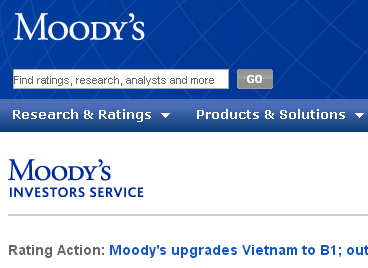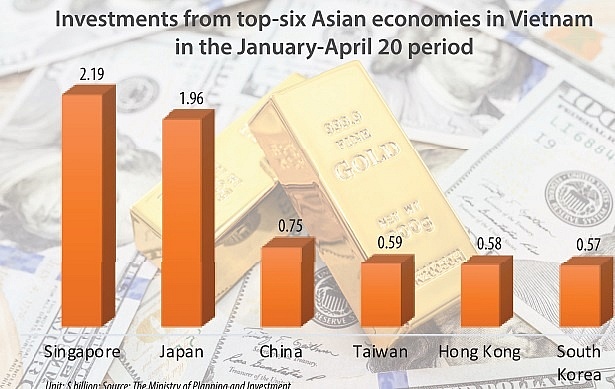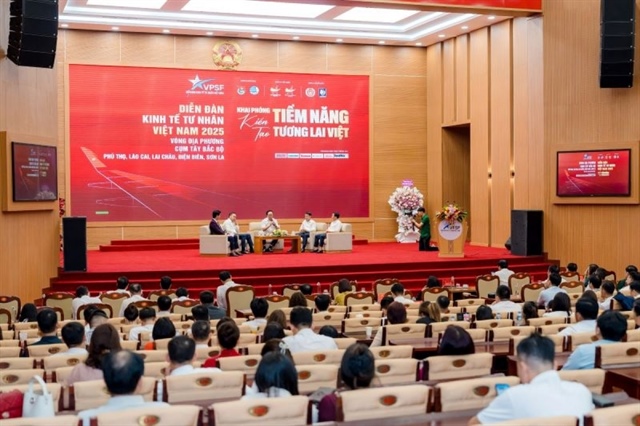Moody's upgrades Vietnam to B1; outlook stable
Moody's upgrades Vietnam to B1; outlook stable
Moody's Investors Service has today upgraded the issuer and senior unsecured bond ratings of the Government of Vietnam by one notch to B1 from B2. The outlook is stable.

The key drivers of today's rating action are as follows:
1) An emerging track record of macroeconomic stability
2) A strengthening in the balance of payments and external payments position
3) An easing in the contingent risks from the banking sector
Concurrently, Moody's has raised Vietnam's long-term foreign currency (FC) bond ceiling to Ba2 from B1, as well as its long-term FC deposit ceiling to B2 from B3. In addition, Moody's has maintained the short-term FC bond and deposit ceilings at "Not Prime.''
These ceilings act as a cap on the ratings that can be assigned to the FC obligations of other entities domiciled in the country.
Moody's has also raised Vietnam's local currency (LC) country risk ceiling to Ba1 from Ba2.
RATIONALE FOR THE UPGRADE
First driver: Vietnam is in the midst of its third consecutive year of broad macroeconomic stability. Although economic growth has fallen since 2012, as compared to the preceding decade, the economy has been characterized by price stability.
Real GDP growth averaged 5.3% year-on-year between 2012 and the first half of 2014, lower than the average of 6.8% between 2002 and 2011. At the same time, inflation stayed under 7.5% year-on-year for 26 consecutive months through July 2014, the longest time it has remained under this level since at least 2000.
Growth over the past two years has declined from its historical trend, but remains strong when compared with rating peers. Much of the growth slowdown has been driven by weak domestic demand and a lackluster expansion of domestic credit. In contrast, the export-oriented, foreign-owned sector of the economy has remained robust, helping to sustain overall economic activity.
Second driver: The strengthening of the balance of payments and external payments position has been underpinned by a diversification in the structure of Vietnam's exports towards more capital-intensive manufactured goods, such as mobile phones and electronics, and away from commodities and traditional labor-intensive products, such as textiles and shoes. Vietnam is becoming a more important node in regional cross-border production networks for electronic goods.
Combined with relatively weak imports, this situation has resulted in the current account shifting from a deficit to a healthy surplus. In turn, this development has contributed to the accumulation of foreign exchange reserves to an all-time high of $35.9 billion, as of April 2014, as well as the stability of the exchange rate.
Nevertheless, Vietnam's balance of payments remains susceptible to capital flows and leakages, as represented by relatively large errors and omissions in its balance of payments.
Third driver: The operating environment for the banking system has stabilized, and risks to the government's balance sheet will likely remain limited. Nevertheless, the overhang from a decade-long credit boom--as manifested in the still large stock of non-performing loans (NPLs)-- continues to constrain the banking sector, undermining its ability and willingness to intermediate credit.
In the context of macroeconomic deleveraging, the stock of domestic credit fell to 108.2% of GDP in 2013 from a peak of 124.7% in 2010. Liquidity conditions have improved, reducing the scale of interbank lending and the degree of interconnectedness in the system. Consequently, contingent risks to the government have eased, but have not been entirely eliminated.
RATIONALE FOR THE STABLE OUTLOOK
The stable outlook for the B1 rating reflects the expectation of continued macroeconomic stability, which, in turn, would further support the restructuring of the banking system and augment the country's external payments position.
WHAT COULD CHANGE THE RATING UP/DOWN
Further upward pressure on the rating could result from the following: an improvement in the intrinsic financial strength of the banking system and the state-owned enterprise (SOE) sector that significantly diminishes contingent risks to the government; fiscal consolidation that reduces deficits and places Vietnam's fiscal profile in line with higher-rated peers; and a further re-profiling of government debt that mitigates foreign exchange risks.
Vietnam's sovereign credit profile is still marked by important challenges. Capital levels in the banking system remain inadequate, especially in the context of the continued weakness in asset quality.
At the same time, risks from the SOE sector persist, posing important constraints to the improving health of the banking system and domestic demand. In addition, the government's fiscal position has eroded over the past few years, driven by weaker revenue performance.
The re-emergence of macroeconomic instability -- which leads to a substantial deterioration in fiscal/debt metrics, a rise in debt-servicing costs, and/or an erosion of the country's external payments position -- could exert downward pressure on the rating. In addition, the crystallization of contingent risks from either the banking system or the SOE sector would be credit negative.
GDP per capita (PPP basis, US$): 4,012 (2013 Actual) (also known as Per Capita Income)
Real GDP growth (% change): 5.4% (2013 Actual) (also known as GDP Growth)
Inflation Rate (CPI, % change Dec/Dec): 6% (2013 Actual)
Gen. Gov. Financial Balance/GDP: -5.4% (2013 Actual) (also known as Fiscal Balance)
Current Account Balance/GDP: 5.5% (2013 Actual) (also known as External Balance)
External debt/GDP: 37.0% (2013 Actual)
Level of economic development: Low level of economic resilience
Default history: At least one default event (on bonds and/or loans) has been recorded since 1983.
On 23 July 2014, a rating committee was called to discuss the rating of the Vietnam, Government of. The main points raised during the discussion were: The issuer's economic fundamentals, including its economic strength, have materially increased. The issuer's institutional strength/framework, have materially increased. The issuer has become less susceptible to event risks. An analysis of this issuer, relative to its peers, indicates that a repositioning of its rating would be appropriate.
The principal methodology used in this rating was Sovereign Bond Ratings published in September 2013. Please see the Credit Policy page on www.moodys.com for a copy of this methodology.
Moody’s



















